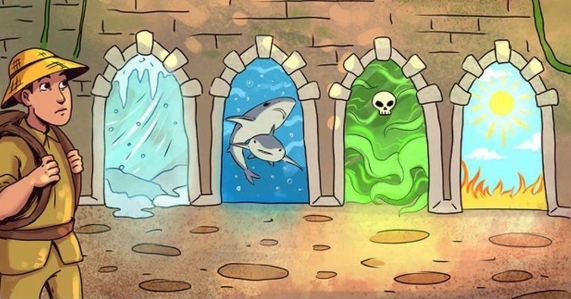Imagine this: You’re trapped in a room with four doors, each leading to a seemingly inescapable death. Your mission is simple but daunting: choose the right door to escape alive. The stakes couldn’t be higher, and the options are terrifying. Here’s the scenario:
- Door 1: Extremely low temperatures — you will freeze.
- Door 2: A hungry shark is waiting.
- Door 3: The door is full of toxic gas.
- Door 4: The heat of the sun can burn you.
At first glance, every choice feels like a death sentence. But as with any great brain teaser, the solution lies in the details. Let’s break this down logically and find the right answer.

The Common Pitfall: Instinctive Fear
When presented with such a scenario, most people make snap judgments based on instinct. Fear dominates their thinking, leading them to avoid the options that seem immediately dangerous. For example:
- Door 2 (the shark) is often dismissed outright because of the primal fear of predators.
- Door 3 (toxic gas) feels inescapable due to its invisible, suffocating threat.
- Door 4 (the sun) is overwhelming because the thought of being burned alive triggers visceral dread.
However, the key to solving this puzzle is to look past the obvious threats and analyze the situation from a logical perspective.
Analyzing Each Door: Pros, Cons, and Hidden Clues
Door 1: Extremely Low Temperatures
Freezing temperatures pose a serious threat, but freezing to death is not instantaneous. It takes time for the human body to succumb to hypothermia, which means this door might offer a small window for survival. However, without additional details about the environment (e.g., protective gear, heating sources), this remains a risky choice.
Door 2: A Hungry Shark is Waiting
A shark is a formidable predator, but there’s an important question to ask: Where is the shark? If the shark is confined to a body of water and you don’t have to enter it, the danger may not be as imminent as it seems. Alternatively, if the shark is on dry land, it’s incapacitated and poses no real threat. This door depends heavily on environmental context, making it a plausible but uncertain choice.
Door 3: The Door is Full of Toxic Gas
Toxic gas is undoubtedly lethal, but it doesn’t linger indefinitely. If the room is ventilated or not airtight, the gas could dissipate over time. Additionally, simple measures like covering your face with a cloth can buy you precious seconds. While still dangerous, this option might offer a slim chance of survival.
Door 4: The Heat of the Sun Can Burn You
At first glance, this seems like the deadliest option. The intense heat of the sun is relentless and inescapable—or is it? The sun follows a natural cycle, rising and setting every day. If you time your escape during the night, the door that once seemed impossible suddenly becomes the safest option. This door, while seemingly lethal, holds the key to survival if approached strategically.
The Clever Solution: Timing is Everything
The best choice is Door 4: The Heat of the Sun Can Burn You—but with a catch. The man must wait for nightfall before opening the door. By using the natural cycle of the sun, he can safely escape without facing the deadly heat.

This solution highlights a crucial aspect of problem-solving: timing and context. What initially appears as the most dangerous option becomes the safest when you consider external factors like time of day.
Why Door 4 is the Best Choice
- Predictability: The sun’s cycle is consistent and reliable. By waiting for night, the man avoids the danger entirely.
- Certainty: Unlike the other doors, which rely on unclear details (e.g., the shark’s location or the dispersal of gas), this option provides a definitive solution.
- Survivability: There’s no guesswork involved—once night falls, the door becomes safe.
This approach not only ensures survival but also demonstrates the importance of thinking critically and looking beyond surface-level threats.
Lessons from the Puzzle: How to Approach Life-or-Death Decisions
This brain teaser is more than just a fun challenge—it’s a metaphor for problem-solving in high-pressure situations. Here are some takeaways:
- Don’t Panic: Snap judgments often lead to poor decisions. Take a moment to assess the situation calmly.
- Think Critically: Analyze all the available information and look for hidden details or alternative solutions.
- Consider Context: External factors, like time or environment, can change the dynamics of a problem.
- Be Strategic: Sometimes, the best solution isn’t the most obvious one. Look for creative ways to approach the challenge.
Why Puzzles Like This Matter
Puzzles like these aren’t just entertaining—they sharpen your critical thinking and decision-making skills. They encourage you to think outside the box, question assumptions, and approach problems from new angles. Whether in daily life or high-stakes situations, these skills are invaluable.
Conclusion: The Power of Logical Thinking
The question “Which door should a man choose to escape death?” is a test of logic, patience, and creativity. By carefully analyzing the options and considering external factors, the solution becomes clear: Choose Door 4 and wait for nightfall.
This puzzle serves as a reminder that even the most daunting challenges can be overcome with the right mindset. So, the next time you’re faced with a difficult decision, take a deep breath, think critically, and remember: the best solutions often lie in the details.